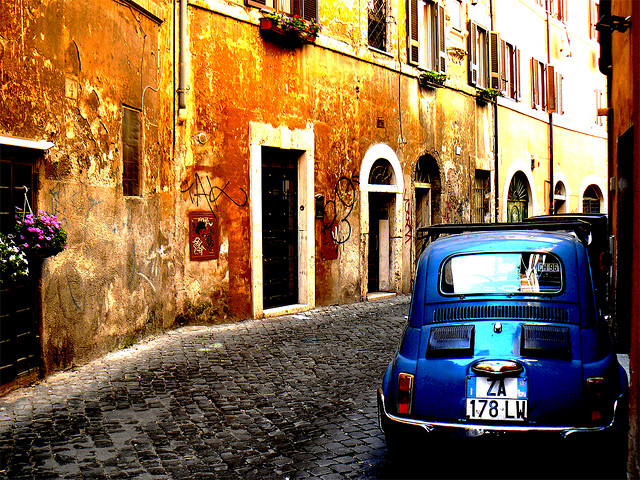
Let’s face it – Rome is magnifica, but because of all the grandiose monuments that make it so, it can also be exhausting. The perfect place to slow down and take it a bit easier whilst still drinking in its beauty and history (not to mention Italian cuisine) is Trastevere.
The Eternal City‘s only remaining mediaeval district, on the west bank of the Tiber River (hence its name, which literally means “across the Tiber”), is reached via the Garibaldi, Cestio, and Palatino bridges, is a gorgeous step back in time largely without the tourist hordes of the Spanish Steps, the Colosseum, and the Vatican.
The cobblestone lanes, the picturesquely spalled façades, the bohemian ambiance – it’s the perfect backdrop for enjoying a cappuccino, glass of wine, or scrumptious Roman cuisine at an outdoor café or trattoria. Pop into the old parish churches. Or come in the morning to browse the San Cosimato outdoor market. It’s all good – and it’s all a slice of traditional urban Rome where real locals still live and go about their everyday lives.
 Topping the list of those churches should be Rome’s oldest basilica, the largely 12th-century Santa Maria in Trastevere, incorporating the remains of a 3rd-century Christian church. The interior mosaics, particularly in the apse (right), will knock your socks off.
Topping the list of those churches should be Rome’s oldest basilica, the largely 12th-century Santa Maria in Trastevere, incorporating the remains of a 3rd-century Christian church. The interior mosaics, particularly in the apse (right), will knock your socks off.
Another ecclesiastical star is Santa Cecilia, dating from the 5th century though with major later additions such as a 1725 façade. Interior highlights include frescos of the Last Judgment and the Baroque statue of the saint herself, lying face down. Then, too, there’s San Francesco a Ripa, with a Bernini statue of a saint in ecstasy that looks almost orgasmic; and San Pietro in Montorio on Janiculum Hill, whose courtyard houses the famed, High Renaissance Tempietto by Bramante. Nearby is the monumental 17th-century fountain Fontana dell’Acqua Paola, which inspired the later Trevi Fountain, and some inspiring views out over much of Rome and its seven hills. The Villa Farnesina is here, too, a complex of gardens and a palazzo with frescos from the masterful Renaissance painter Raphael.
Such grand landmarks notwithstanding, much of what’s so appealing about Trastevere is its postcard-pretty corners and its street life. Once known for its Middle Eastern immigrant communities (especially Syrians and Jews), it still attracts immigrants – these days including many Chinese and Pakistanis, who mingle with Romans whose families have lived here for generations.
You’ll find charming little shops selling book, antiques, vintage clothing, and more. And you must stop for a cold one at the Bar San Calisto, in the piazza of the same name, and check out the jazz and blues acts at Big Mama music club (Vicolo di San Francesco a Ripa 18). Excellent trattorie are thick on the ground, where the things to order (besides, of course, the superb Roman pizza) are dishes like fiori di zucca (fried zucchini flowers stuffed with cheese and anchovies) and y carciofi alla giudia (fried artichokes, “Jewish style”). Then late at night, the pubs fill up with the young and the restless, many of whom come to Trastevere just for its vibrant nightlife.
All signs that new generations continue to inject life and dynamism into an ancient part of Rome that all visitors should put on their itineraries.
More information: Rome.info.
Best Iberia fares from the USA, from Spain.
images | mozzercork, Goldmund100

